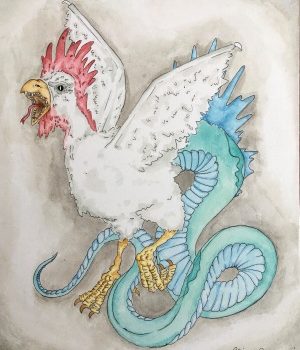The Snake

Serpents constitute a fascinating and frightful theme. Some suck milk, others live in the house, some are very dangerous, while others are a source of wellbeing.
In the kingdom of the streghi (fairyfolk) various figures take us back to the ancient Basilisk: the Biscio Bimbin, half-snake and half-child, which rolls and weeps; the flying dragon that clings onto bell towers or is hit by rifle fire or defeated by a warrior; the ruler of the Motri (king of the serpents) who calls serpents towards him and if seen can be a figure of ill fortune; the Devasto, a huge creature who lives amongst the ruins of an abandoned town.
An interesting example is the legend of the Castellarino from Regnano (MS), which is the highest point on the ancient road between Garfagnana and Lunigiana. This snake has wings and appears only to those who stay awake the whole of St John’s night (23 June) while standing in a particular place. Spitting several times into the serpent’s mouth will cause it to transform into a woman who can show where treasure is hidden. The relationship between women and serpents is ancient, as is the word “basilisco” (Basilisk) which crops up from time to time almost everywhere: a fearful being in some places. In mediaeval times the basilisk was said to be born from “a seven or fourteen-year-old hen’s egg, laid on a dung heap and hatched by a toad, frog or serpent”.
Umberto Bertolini
Translation by Linda Barwick, The University of Sydney, Australia
Videostories (only in Italian)
Below a list of videostories to read/listen to:
- Il serpente di Sillano
- Il biscio bimbin
- Il biscio bimbin – 2
- Il Basilisco di Pasqueio – Sillico
- Il biscio bimbin – 3
- Il biscio bimbin – 4
- Il biscio bimbin – 5
- Il Devasto di Bergiola
- La serpe del Marchiò – Valle
- Il drago volante – Casciana
- Il serpente volante – Sillicagnana
- Il Devasto di Bergiola – 2
- Il regolo dei motri – Minucciano
- San Giorgio a Gragnana
